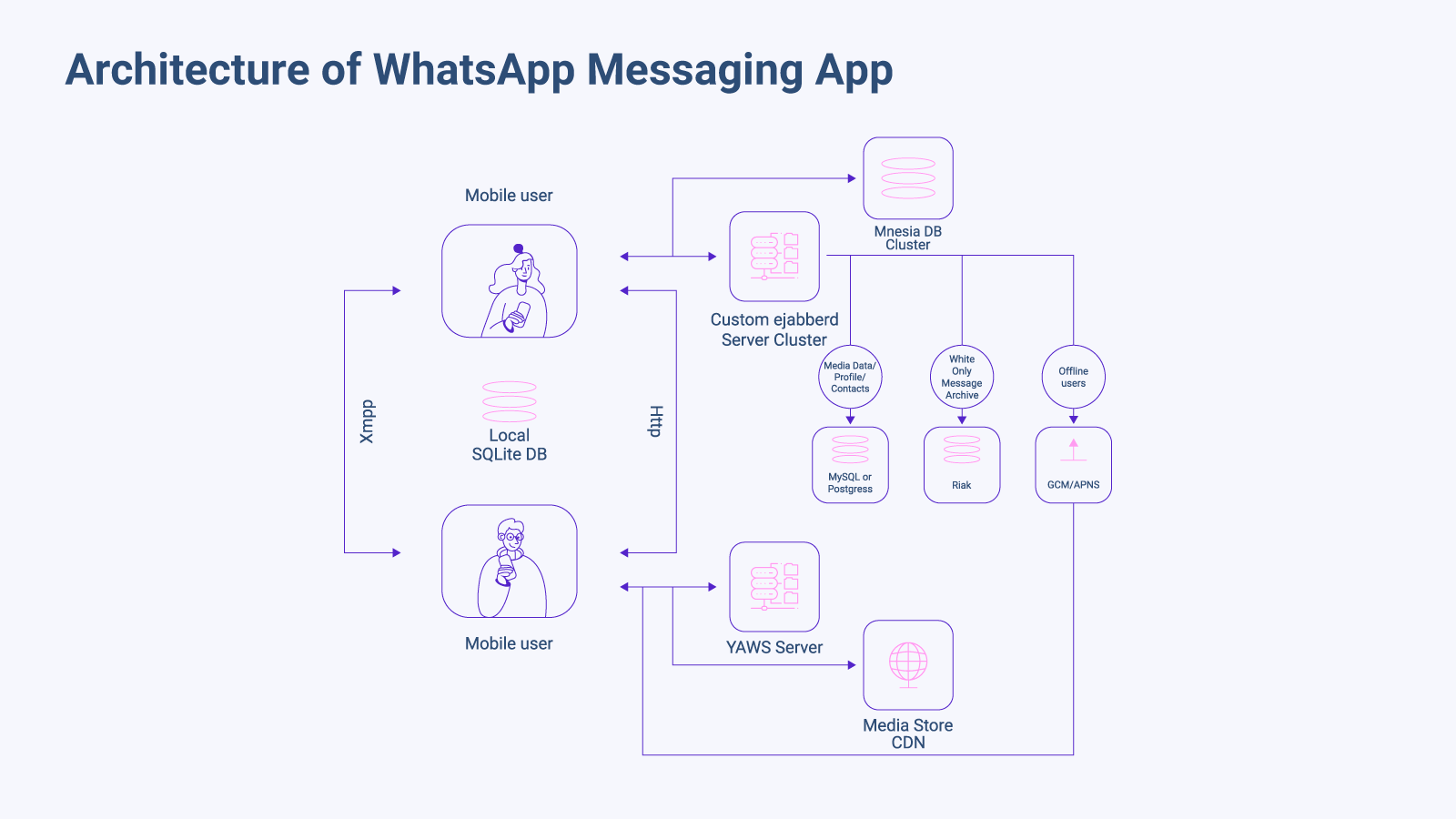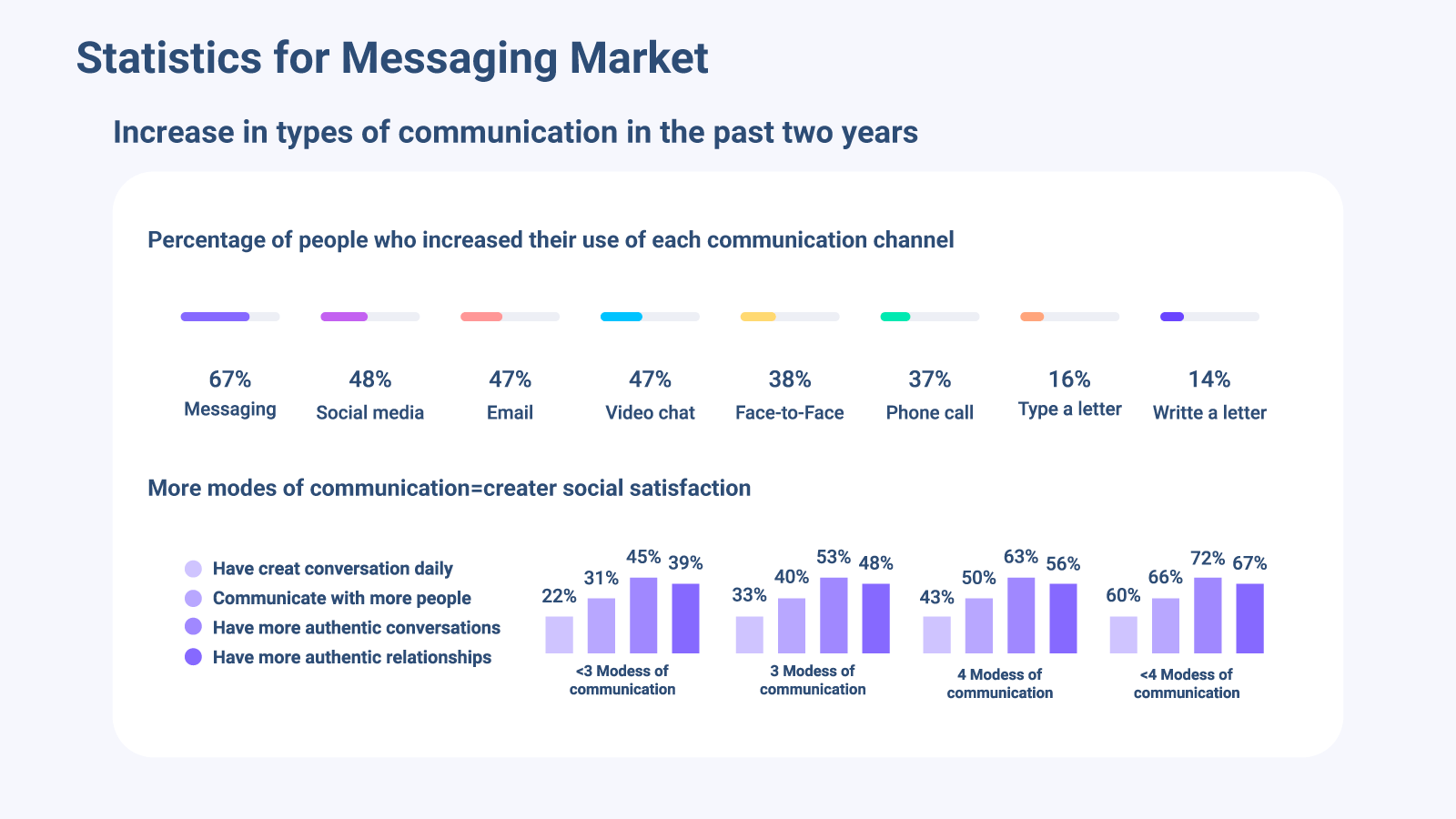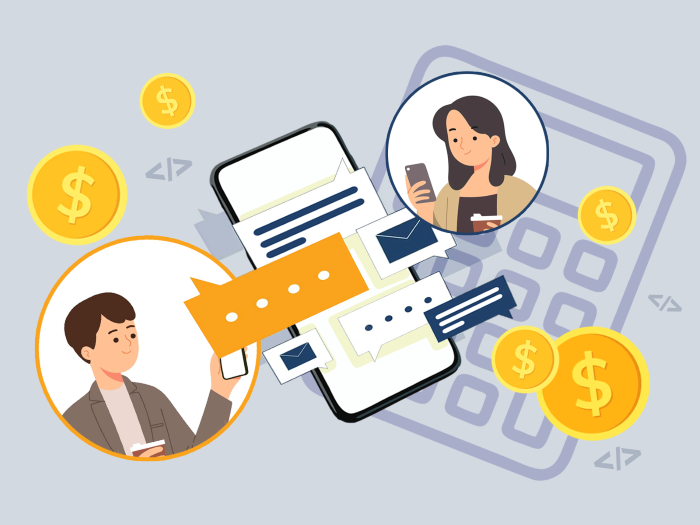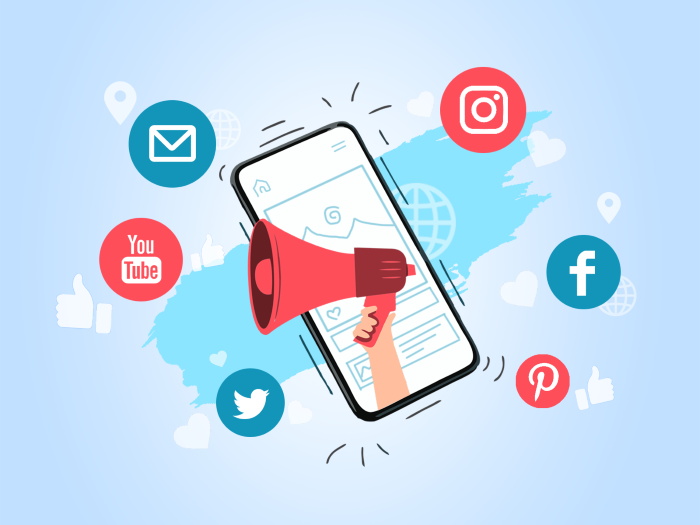How to Create a Messaging Application from Scratch in 2024
A messaging app is a platform or a chat application enabling users to send and receive instant messages and connect. Think of the most popular messaging apps like Facebook Messenger, WhatsApp, Telegram, Viber. Which one do you use?
Are you interested in developing software for messaging? Possibly you require a new chat app to streamline business processes inside your own organization? Or simply want to innovate the messaging app market?
Online communication has become a new normal these days. Communication software like WhatsApp, Viber, Telegram, and other tools that are an integral part of our lifestyle.
Just imagine, over 100 million messages are sent out each minute globally, stated by Microfocus. No wonder why the messaging app market grows rapidly.
In January 2023, two billion people were using WhatsApp messenger every month. The app is used by many people, especially in markets outside the US. It's one of the most common social apps on mobile around the world. WeChat got more than 1.3 billion users, and Facebook Messenger gathered about 930 million people all over the world.
Why Do People Use Messaging Apps?
Can you imagine that over 41 million messages are sent every minute? With over 80% of smartphone user engagement, messaging apps are the most popular types people use. People do need messenger apps to stay connected not only for entertainment but also for business purposes, so the segment has all the driving forces to get bigger.
This data visualization video shows. go., the most popular instant messaging apps based on monthly active users.
The current state of thing with coronavirus crisis also underlines the importance of stable, secure, and high-quality online messengers.
If you have a concept of creating a unique messenger, this article is a complex guide into the tech and business details, as follows:
- what features are must-have in messaging software these days
- advance functionality that will help you to stand out
- tech stack to use and technologies applied in the market leaders (WhatsApp, Telegram, Skype)
- building the revenue stream in a messenger
- challenges during messaging app development
Get right into the key insights.
For starters, let’s outline what functionality you should implement to develop a viable product.
These days, it is necessary to include the must-have features that would make the system work and apply some sort of innovation to make the app appealing to the target users.
The idea is to start a messaging app with core features and unique selling points represented by the unique experience and exciting features. The next step is to scale this chat app MVP further based on the real-user feedback.
KEY FEATURES IN MESSAGING APPS
Let's take a look at what core features should be used to make messaging easier in 2024.
1. AUTHORIZATION
App users should have the possibility to create a personal account. The wise idea is to implement a user sign-up option in one click via social media (e.g., Facebook, Twitter, Instagram).
Depending on the app’s objectives, you may include authorization via email, phone number. For increased security, it is possible to interconnect with the device with the help of confirmation SMS.
2. ACCESS TO CONTACTS
For enhanced user experience, your messaging app should automatically access to existing user contacts and get them imported to the messaging app. A strategic step is to highlight for end-users which contacts already use this messenger and give an option to invite those that still don’t.
It is also a wise aspect if users can engage others to join the messenger with a simple invitation.
3. ADVANCED CHAT OPTIONS
It is hard to create a product on the same level as the giants like WhatsApp or Facebook Messenger in in this highly competitive market. As a startup project, your messaging app should have minimum functions to be validated. For the update and final deployment, think of advanced options that will bring value. Integrating top social channels and developing a more personalized user experience can help your product succeed on the market.
4. EXCHANGE MESSAGES AND FILES
These days, users need to have the possibility to exchange files, videos, photos, and other content. Therefore, make sure that your messaging app supports different app attachments.
This feature can be implemented by using distinct APIs. Do not forget that your app should have an option to send files from the device and capture real-life moments from the app directly.
5. SHARING REAL-TIME LOCATION INFORMATION
Users can share their location with others in many apps, like parking spots, offices, restaurants, etc. This feature is developed by utilizing packages of Location Manager Class on iOS and Android.
Telegram messenger has implemented this feature, which provides excellent user experience. App users can even create routes from the starting to the destination point.
6. PUSH NOTIFICATIONS
It is an essential element in any messaging app development. It is the function that allows the user to check whether someone sends a message or not. Developers use Google Cloud Messaging and Apple Push Notifications to implement this functionality.
7. CLOUD STORAGE AND BACKUP
To generate user satisfaction and get user retention, your application needs to be customizable. The users do like the idea of playing with app interfaces, themes, and colors to make it more personalized and attractive. Keep this in mind when comprising the app functionality list.
TOP 7 most secure messaging apps in 2024
Digital technologies are all about making life comfortable, but at the same time, it is about security concerns. Sharing messages, photos and files may not be safe especially if the platform is not powered by security technologies. Today there are secure messaging apps with end-to-end encryption built on blockchain technology that is absolutely safe and secure. Still, before thinking of making a secure app, consider whether it meets your business objectives or not.
Do you want to know which are the most secure messaging apps out there and how they can protect your valuable data? We compiled a list of reliable encrypted messaging apps because the struggle to keep our data secure is fiercer than ever.
TECHNOLOGY STACK TO BUILD APPS LIKE WHATSAPP AND TELEGRAM
First, we list possible tech stacks to utilize in chat app creation, followed by for a few successful messaging apps. It makes sense to understand how these applications are created.
WhatsApp tech stack
The Technical Stack used to develop WhatsApp includes Erlang, FreeBSD, Yaws, PHP, and XMPP.
- Erlang - functional language used to script real-time chat apps.
- FreeBSD - open-source operating system to power modern servers and embedded platforms.
- Yaws - Erlang-based web server used for dynamic-content apps to run WhatsApp as a standalone web server.
- PHP - general-purpose scripting language for web development.
- XMPP - the communication protocol - the core of WhatsApp for sending real-time messages.
Let’s dive right into these insights.
TECH STACK TO BUILD YOUR MESSAGING APP
Depending on your product’s goals and functionality, you should understand creating a cross-platform or native messaging app. The difference lies in the app availability of the app across the majority of platforms simultaneously or individually for each operating system.
Both options have their pros and cons. Native app development ensures higher system performance, stability, security but requires more investments.
TECH STACK
MOBILE APP DEVELOPMENT
| Android | iOS | |
| Programming language | Java, Kotlin | Swift, Objective-C |
| Local Storage | Core Data | Shared Preferences |
| Preferences | User Defaults | Shared Preferences |
| Social Authentication | Facebook SDK | |
| Chat | Starscreen | OkHttp |
| Video and voice calls | WebRTC | WebRTC |
BACKEND DEVELOPMENT
| Programming language | Java, Java, HTML5, CSS3 |
| Automation frameworks | RSpec, PhantomJS |
| SQL data storage | PostgreSQL |
| Social Authentication | Facebook SDK |
| Web server and web application server | Nginx |
| Hosting | Amazon Web Services |
| Key Value storage | Redis |
Server-side software can be coded in PHP, Ruby, Erlang, and similar. Your software development vendor should advise you of what is more suitable to use in your case.
Also, one of the most common product architectures is a software bundle of LAMP. Linux as the operating system, Apache- web server, MySQL database, PHP as a back-end language.
Alternatively, you can use a PostgreSQL database, Nginx web server, Nodejs, Ruby, or JavaScript for the backend development.
It is also necessary to use distinct services and libraries, namely:
- Amazon services - for data storing
- Socket.io - library for real-time communication between a browser and server
- Social media integration - Facebook, Instagram, Twitter, etc.
- Analytical tools - Flurry, Google Analytics, Firebase, MixPanel, etc.
- Maps & Navigation - Google Maps, Google Places
- SMS services - Twilio
- Email marketing - MailChimp, Elastic emails
- Payment gateways - Braintree, Stripe, PayPal, etc.
- Push notifications - APNS (iOS), FCM (Android)
The general idea is to go for open-source technologies, which prevent building everything from scratch. Instead it is possible to use existing well-proven libraries and frameworks.
When selecting a tech stack for your messaging app, put users and their experience in a priority and consider the speed, performance, and security of the chat app.
TECHNOLOGIES USED TO BUILD A WHATSAPP MESSAGING APP
Operating system FreeBSD is used in this app. Its developers believe that the Linux system is more bug-creating, which is a somewhat debatable statement.
Initially, the system used XMPP (Extensive Messaging, Presence Protocol) to manage one-to-one and group communications. Further, the team created the internal protocol to support communication with end-to-end encryption.
WhatsApp uses YAWS (Yet Another Web Server) for data storing and HTML5 WebSockets to create a solid connection between a server and messenger.
The system uses LYCE/LYME architecture consisting of open-source solutions to develop highly available and dynamic pages.
- Operating system- Linux
- Web server – Yaws
- Databases – Mnesia, CouchDB
- Programming language- Erlang
To note, Elixir programming and its Phoenix framework are great to utilize for complex and high-load projects. These technologies ensure smooth system operation, remarkable efficiency, and the ability to handle lots of traffic.

TECH STACK WITHIN THE TELEGRAM APP
Telegram is one of the most significant messaging apps with the high protection and smooth performance. As far as it is known, the messenger was coded with the following technologies:
- iOS app – build by utilizing Objective C and partly Swift
- Android app – created with Java programming language
- Windows Phone app – uses C#
- Web platform – uses Javascript and Node.js
- Mac app – is developed with Objective C
Also, the Telegram team developed a specific data protocol, MTProto Mobile Protocol, that ensures the speed and security of its service.
TECHNOLOGIES UTILIZED IN THE SKYPE PRODUCT
Before Microsoft purchased Skype, the product used C++ for the back-end in Debian servers. Further, the team included new services by using Azure Suite (written in C#).
The client Skype apps include the C library to support the low-level app functionality. To mention, Skype is a cross-platform product, and only a thin layer of client apps (UI layer) uses Java and Objective-C for Android and iOS apps correspondingly.
CHAT APP MONETIZATION STRATEGIES
How can you monetize your messaging application?
We have an answer for you with a few options to build revenue streams in this app type. These strategies include:
- In-chat advertising – these are multiple ways to include ads inside the messaging application. This can be a banner ad, pop-up ad, native ad, and similar. Viber messenger uses this strategy and shows targeted ads and messages and earns millions.
- In-app purchases – this model implies users pay for some advanced app features, access specific content, remove the ads in the messaging app, purchase sticker packs or games. The latter option is used in the LINE chat app, where users play right in the messenger.
- In-app payments – corresponds to the typical monetization strategy, where users make payments inside chat applications.
- Integration of a chatbot – this is an advanced monetization possibility once your app gets user interest and base. It allows you to gain revenue from CTR (click-through rate) by providing relevant recommendations.
- Sponsorship – in this model, revenue is generated via in-app sponsorship to create brand awareness. This method is best to utilize once you have enough pull of app users.
- Pay per download – you may use this method if you are sure to provide a unique and new app functioning, and you tested the hypothesis that users will purchase the app. In general, users buy only those apps that are very specific and have top performance.
- Subscription fee – similar to pay per download, but the payment is made regularly, only when clients use a messaging app (e.g, monthly, annual basis). Interesting fact, that the WhatsApp initial cost $0.99 per year after a trial period.
- Content merchandising - creating chat themes, wallpapers and stickers related to any brand. The promotion of the brand brings win-win results for the app and the brand.
- Official accounts - this type of messaging app is built for brands, public figures or celebrities who are willing to get close interaction with followers.
- White labelling - this strategy supposes chat app development for enterprises’ internal use or customer support.
Either method you select, base your monetization strategy on the market analysis, current user experience. Also, these days users demand top-notch app performance and service quality to pay for it.
Our team is ready to help you build intelligent technology solutions to get your brand closer to your potential customers with a chat app. Get in touch with our team, and we’ll provide you with a free initial consultation and project estimate.
How much does it cost to build a messaging app?
Regardless of the application type, the development cost is estimated based on its complexity and features. Even if you try to make a rough cost estimation, we still need to consider details like platform, app complexity, development team and hourly rates. The average price for MVP starts from as low as $25,000 or as high as $50,000.
Drop a line for a free consultation, and mobile application cost estimation, and our team will get back to you with an offer.
CHALLENGES OF BUILDING A CHAT APPLICATION
Before you proceed with the actual development of the messaging app, consider the following challenges on the way and further. This information will help overcome pitfalls and remove risks and future troubles in a messaging app functioning.
1. DEFINING REAL-TIME FEATURES
The industry of messaging apps is led by giants that have raised the bat and, to tell the truth, it will be hard to compete with them. On the other side, we have users that demand new features, stability, and functionality. To become a competitor, the messaging app should be way much more than a chat app. After a successful launch of MVP, think of all the features for user satisfaction:
- Custom fonts and stickers
- Chat muting
- Privacy status updates
- Video and voice calls
- File transfer
2. SECURITY ISSUES
High-end app security and protection is the number one task during messaging app development. It is necessary to provide personal data protection, message encryption, and build secure project architecture.
Ensure that you provide as much protection as possible, namely:
- end-to-end encryption via protocols (e.g XMPP)
- usage of cryptographic keys
- plan the product architecture for secure data storing
- include privacy policies when using your chat app
- develop extra functionality, which users can enable, for messenger protection
3. THE TOOL STACK
To make your app work, it should first be well packed and built. Think of existing apps and find case studies that will help to define the tech stack best working for your project.
4. OVERLOAD OF THE SERVER
This issue may arise with the growing number of app users. Optimization of an app like WhatsApp requires loads of technical efforts and capable developers.
Choose the server setup and capacity, also supported by proper hardware, to quickly ensure app scalability. Make sure that servers are tuned up to provide stable work during the peak load periods.
It is highly recommended to plan and create a list of potential server bottlenecks with a precise action plan.
5. FLAWLESS APP UPDATES
Messaging apps have a constant connection with their users and constantly process their data. During new functionality deployment and app updates, make sure not to lose existing data by servers and architecture configuration.
Scalability of the real-time chat apps is a rather challenging assignment, which is highly dependent on the set architecture.
6. STABLE CONNECTION
Many reasons can influence the network loss and switch from smartphone internet and Wi-Fi. To note, during such losses, the last message can be lost in case of a temporary disruption.
Thus, you should create your messaging app to outline your app as a reliable tool that keeps the connection stable and reproduces lost messages during disconnection.
HOW LONG DOES IT TAKE TO DEVELOP A CHAT APP
The timeline required to develop your messaging app depends on several factors. These include but are not limited to:
- number of platforms you plan to build your product for
- the complexity of features and design
- number of features included
- attributes of the selected software development vendor (location, rates)
- number and peculiarities of 3rd party services to integrate
Any software development consists of special services like UX/UI design, Architecture planning, iOS development, Android development, Backend development, Quality Assurance, etc.
In general, be prepared that it takes around 3-5 months to develop an MVP of the chat app. Note that in most cases, this involves only basic app functionality. In terms of the budget, the sum is highly dependent on the development vendor you choose.
The 3-5 month of development corresponds to $25,000 – $50,000 for one platform (iOS or Android). At this cost, usually, you receive a team of 4-6 specialists like iOS/ Android developer, Backend developer, QA engineer, Project manager, Designer.
To visualize what to expect, here is a chart with development time per feature. Keep in mind that we are discussing MVP features for the first launch. Later the app may be updated with new functionality.
| App Features | Development Time |
| User registration | 12-16+ hours |
| The messaging feature | 200+ hours |
| Multimedia file transfer development | 12-16 hours |
| Contact sharing | 8 hours |
| Location | 8+ hours |
| Voice and video calls | 200+ hours |
| Establishing settings | 8 hours |
| UX/UI design | 100+ hours for prototypes |
Thus, plan your timeline and budget accordingly. A wise strategy is first to finalize your product concept, business vision and prioritize app functionality.
CONCLUDING IDEAS FOR CHAT APP DEVELOPMENT
Online communication is a core part of our daily life – 80% of adults, 91% of youngsters text each day. This area will evolve and innovate each year, which has a vast potential for your investment today. The more modes of communication exist, the greater social satisfaction is.

Here is a short case study for more practical information about the messaging app and the development experience. The expertise of Addevice covers the development of different apps, including entertainment and messaging. One of the relevant projects was “WOO – Women’s dating platform app,” a dating app and messaging platform to get connected.
The MVP of the app was built on stakeholder requirements based on the following tech stack:
- Swift, Java
- Firebase
- CoreData, Socket.IO, Game KIT
- MongoDB, Java, Big Data (Hadoop, Casandra)
- AWS and AWS File Storage
- Alexsa
- CocoaPods
The chat applications business model
In the first stages of project planning and defining the business model, a significant portion of decision-making goes to research and case studies. For messaging apps, the best working model of messaging apps so far is WhatsApp. It means when building your messaging app business model.
As an alternative to SMS messages, WhatsApp became the second chat app globally for being secure, private, and reliable. The first funding of WhatsApp was equal to $250K; the next two investments were the most significant, about $60 million that was the primary source of income for WhatsApp employees for a long time. Later, WhatsApp was acquired by Facebook as a valuable asset and started implementing new business projects. As a recent strategic change, Facebook launched the WhatsApp Business application and API allowing businesses to integrate WhatsApp for business purposes.
The Customer Journey Map
Problem
(what are the critical problems faced by your customers?)
- Users can’t keep in touch with the nearest and dearest ones while they are apart
- Expensive phone calls & SMS
Solution
(what are your solutions for your customers’ problems?)
- Cheaper SMS & voice calls via the internet
Value propositions
(what value do you deliver to your customer?)
- Free application
- Real-time messenger
- Be reachable by everyone
- Simple, intuitive interface
- Secure messaging
Key metrics
(which metrics indicate how well your company is doing)
- Monthly active users
- Customer retention rate
- Audience engagement
Channels
(Though which channels do your customer segments want to be reached?)
- Word of mouth advertising
- WhatsApp web application
- App Store/Google Play
- Social Media
Customer segments
(who is your intended customer?)
- Families and friends who are apart but have smartphones to stay in touch
Unfair advantage
(what is your edge over competitors?)
- First app to market
- Technology solutions
FOLLOW THE NEXT PROCEDURE WHEN STARTING A MESSAGING APPLICATION
- Prepare a solid and complex market analysis. Review what the competitive products do, the functionality they have, and check on how you can offer the improved service
- Figure out a unique selling proposition of your messaging app
- Finalize your strategy, business objectives, and define a course of actions
- Find and partner with a highly experienced and capable IT vendor
- Develop and launch the MVP of the chat app to test user feedback
- Launch a creative promotional campaign to spread the word about your product
- Collect and analyze user feedback to continuous chat app updating and improvement
As a final word, success pursues only the brave.
The messaging app market has unrealized functions and experiences that the clients will be fully engaged with.
You can simply start by studying WhatsApp, Facebook, Slack, Telegram products and contact the Addevice team.
We can elaborate on the project development process, define app functionality with you based on your goals, and estimate your project cost and timeline roughly. In the end, you will have a solid plan of how to develop a unique messaging application.
How to Build a Messaging App, Communication Applications, how much does it cost to build a messaging app, Chat App Development, Cost to Build a Messaging App, How to Make a Social Media App, Hybrid Apps, Build an App Like Uber, Messaging App,
Develop Your Messaging App
Foster real-time communication with your own messaging app
Our Expertise Covers:
✅ Real-time chat and multimedia sharing
✅ End-to-End encryption for enhanced security
✅ Customizable features for a unique messaging experience
Table of contents
FAQ
Follow the major steps to build a chat app from scratch:
- Plan the chat app structure.
- Choose app monetization
- Find experienced add development team
- Prioritize features
- Design your idea
Platform App Development Time App Development Total Cost iOS 700-900+hours $35.000 – $45.000 Android 800-1100+hours $40.000 – $55.000 backend 500-700+hours $25.000 – 35.000 UI/UX (one platform) 60-80+hours $3.000 – $4.000
The development of messaging apps requires relevant expertise, skills, and knowledge of a development team. Collaboration with an experienced team can help you turn your idea into reality.
Follow the major steps to build a chat app from scratch:
- Plan the chat app structure.
- Choose app monetization
- Find experienced add development team
- Prioritize features
- Design your idea
 How Much Does It Cost to Build a Messaging App?
How Much Does It Cost to Build a Messaging App?
 How to Make a Social Media App: Development Guide 2024
How to Make a Social Media App: Development Guide 2024
 How To Create A Dating App: From Concept To Successful App
How To Create A Dating App: From Concept To Successful App